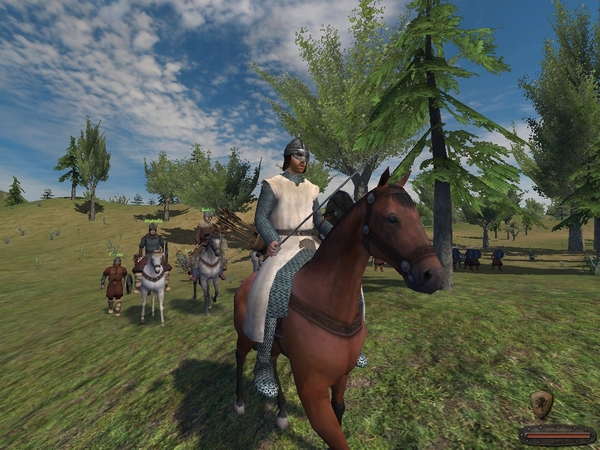Mount & Blade
Longtime Readers know that I occasionally write here about games that I find particularly interesting and/or impressive. So I’d be remiss if I didn’t share a few words about Mount & Blade, which is easily one of the most engrossing games I’ve encountered in years.
By looking at the screenshots you might think that Mount & Blade is yet another fantasy role-playing game, with elves and wizards and what not, but it’s not. Instead, it’s focused like a laser beam on one particular goal: providing gamers with a realistic (yet still fun) model of combat in a medieval world.
The developers of Mount & Blade, a couple in Turkey, wrote it as a labor of love born from their frustration with the cartoony worlds typically depicted in fantasy games. In these games, beefy heroes swing gigantic broadswords as if they weighed nothing, stopping periodically to quaff health potions that magically bind up their wounds. It’s a familiar oeuvre, but one that bears little resemblance to how medieval battles were actually fought.
So in their game, they went in the opposite direction, focusing on the mechanics of medieval conflict. In Mount & Blade, when you fight someone, you find yourself quickly falling into the rhythm of thrust-and-parry that will be familiar to anyone who has watched fencers in action. You can’t just click frantically on your opponent; you have to parry his blows while watching his stance, waiting for an opening — for a moment when there’s a part of his body that he can’t easily cover with sword or shield — and then launch your own blow in that opening before he can recover. The game’s control scheme makes this all quite fluid and natural; with a little practice it becomes second nature.
Which is good, because mastering the basics of the sword is just the beginning. The game starts you off as a lone adventurer in the medieval land of Calradia, but you quickly discover that running around alone is a good way to get killed by a band of marauding highwaymen. (Even the best swordsman can’t fight five enemies at once.) So, as you travel from town to town, the game gives you opportunities to build up your own band of warriors. These bands start small, but they can grow quickly as your fame increases. And that means when your band takes the field against another band, you can easily find yourself in the middle of a swirling melee with 100 or more warriors battling it out.
And in such a melee, you find, the man on horseback is king. If you acquire a horse, you suddenly realize exactly why knights ruled the medieval European battlefield; you can charge through a horde of foot soldiers, cutting them down with swings of your sword, without taking a scratch. And if your horse is charging with enough speed, it becomes a weapon in itself, its hooves trampling any poor unfortunate pike-wielding peasant who finds himself in your way.
Beyond just swords, the game models a wide range of medieval weaponry, including pikes, staves, axes, bows, and crossbows. Each class of weapon has its own unique style of use and its own strengths and weaknesses. Archery is realistically complex, with arrows being blown about by the wind and crossbows taking forever to reload. As a result, choosing a weapon that fits your fighting style and then mastering it is a very rewarding experience.
The game layers on top of this combat model a “sandbox” strategic mode, in which you can go anywhere, picking up quests and companions along the way. There are no set objectives in Mount & Blade, no defined way to win; you choose your goals and then set about achieving them. Maybe you want to be crowned king of one of Calradia’s five nations; or build a band of raiders, looting and burning everything in sight; or rake in cash by trading goods and build a fortune. Like other “sandbox” games (think Grand Theft Auto III or Sid Meier’s Pirates!), it’s up to you what “winning” Mount & Blade means.
The complete package is a radically addictive game that I can recommend without reservation. And it’s reasonably priced to boot — $30.
If you want to try out Mount & Blade, you can download it for free from the developers’ site and give it a spin. The demo version lets you play with no restrictions until your character reaches level 6, at which point you must buy an activation code to keep playing. (The code costs the same as buying the game in a box at a store, so there’s no risk in trying before you buy.) That gives you plenty of room to explore the world of Mount & Blade and discover for yourself why it’s so compelling.


Comments
darkgift222
October 13, 2008
11:53 am
i cracked the game and played the full ver for free
Ginger
December 10, 2008
3:59 pm
I don’t like any kind of fighting games. Do you know of any adventure games for xbox 360 that might let you solve puzzles or codes or any kind of other adventury-detectivey stuff? I heard Tomb Raider was good, but on the box she’s shooting at things and that makes me all high-strung and takes the fun out of it.
Blah
April 19, 2011
7:43 am
I`ve got the game and its exciting and fun. I`m high in the game now and along the way I`ve found that a good quality axe is the to go if you like slashing hundreds of men before your eyes.
Michael
June 14, 2011
7:24 pm
A game you might like is the hobbit, which features a small amount of fighting but is vastly puzzle based. the game was definitly geared toward that genre. Even my grandmother liked it (and she wont have anything to do with fighting games =))